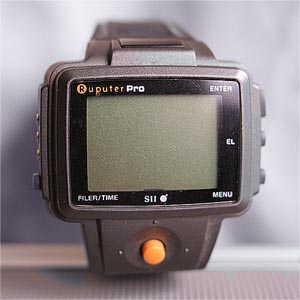 |
|
|
What's new in my pocket computers pages?
Friday, October 15th : Ricoh RDC i-700 received
Device securised this morning! No page for it yet; will be one some day.
Wednesday, September 15th : Sharp MI-10 added
Created a page for the Sharp MI-10 i've received.
Friday, July 23rd : new homepage, new machines listed
My collection reached 49 units yesterday as i've received 2 new watches. Added them to the list (no pages yet) and changed the homepage to a weblog format.
|
|
 |
|
 |
 This feature will soon be available
This feature will soon be available
|
 |
|
|
Seiko Ruputer Wrist Computer Watch
"PC compatible" computer watch
|
** THIS ITEM IS NOT FOR SALE! **
IF YOU ARE LOOKING FOR A USER MANUAL
or IF YOU ARE LOOKING FOR A RESELLER/REPAIR STATION,
I'm sorry, but I will not reply to user manual requests or to dealer location inquiries anymore.
Please read my FAQ page that might help you if you have any of these questions in mind.
Feel free to contact me for any other question or comment regarding this machine!

Special features :
- an actual computer in a wristwatch!
- simple joystick-based UI
- programs can be downloaded from a PC
- dev kit available
Weak points :
- Really bulky. Huge, actually.
- low battery life
Related machines in my collection :
Early computer watches from Seiko :
Databank watch :
 Seiko DATA-2000 Seiko DATA-2000
Programmable watch :
 Seiko UC-2000 Seiko UC-2000
PalmOS watch :
 Fossil Palm OSWrist PDA Fossil Palm OSWrist PDA
Casio graphic display Touchscreen watch :
 Casio VDB-1000 Casio VDB-1000
|  |
Page under construction.
In the early 1980's, Seiko has made several experiments in embedding the processing power of a computer into a watch. The "UC" lineup, for example, featuring such watches as the UC 2000 explored a weird concept : the watch itself was given a 4bit processor, and could be attached to an external keyboard with a built-in 8 bit processor (8 bit was the norm back then). Some programs could be downloaded from the keyboard to the watch, but only as small ready-made binaries, it was not actually possible to program the watch with the keyboard, yet these products are certainly to be counted among the "wearable computing" pioneers.
These years also saw other experiments from Seiko aimed at connecting a watch to a desktop computer. A Seiko watch existed which offered an Apple-II connection interface. The idea there was to transfer PIM information from the Apple to the watch memory, not to run programs on the watch.
15 years later : 1998 Seiko is back with a new, improved, better wearable computer! The "Ruputer", as it's named, offers a full graphic display, a GUI and a small joystick for user interactions.
Although it was said at the time that the watch was "PC compatible", it's architecture and OS are actually too far from regular PCs to be actually compatible. The watch, however, will communicate with PCs via a provided interface, has a complete filesystem, and handle files like ".bmp" and ".txt". Executable files have a ".EXF" extension.
The watch is very fun to carry and to play with. I have not tested programming, but it should be fun as well. But apart from the immediate fun, at least two problems prevent from adopting the watch as an actual timepiece for everyday use. First, it's really huge and not that nice. Second, the batteries consumption is an issue. Even is several features are included to keep consumption low, it would be necessary to replace batteries at least once a month depending on the average use.
Several versions of the watch were released, including such changes as a larger memory (4 MB instead of 2), different casing colors; and the watch was also distributed in the USA by Matsucom as the "onHand PC".
| Processor : | 16 bit 3.6 MHz |
OS : | Proprietary, GUI interface |
| RAM : | 2 MB flash, 128 KB execution memory |
ROM : | ?? |
| Graphic display : | 102*64 pixels |
Text display : | variable fonts |
| Display : | 4 grey |
Input : | 8 dir. joystick + 6 function buttons |
Built-in Applications :
PIM apps, file system (more details to come)
Open to other applications :
Yes
Ports :
1 proprietary serial port, 1 IR port
|
|
|
 

|